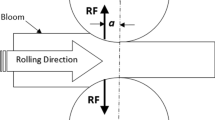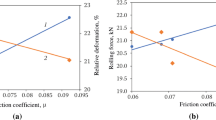Abstract
The medium carbon steel bars are widely used in automobile sector, mining, shipping, and forging industry. The use of SAE 1541 grade bars is quite common due to their affordability and adaptability. Basic production process of the metal bar involves heating the billet in reheating furnace up to 1200–1210 °C followed by passing it through a pair of grooved rolls in a rolling mill. The steel industries have been striving for productivity and better yield of hot rolled bar products. The roll separating force (RSF), driving torque (DT), and end crop length (ECL) are the important issues to be controlled for quality production, maximization of yield, minimization of rolled bar process scrap, safety of mill, and reduction in energy consumption. The response parameters depend on several process parameters – rolling speed, billet temperature, reduction ratio (strain), billet size (cross section area), roll diameter, etc. This paper presents a study on the effect of process parameters on these response parameters during rolling of SAE 1541 steel. Simulation of the rolling process has been attempted using FORGE® Nxt 1.1. The simulated results so obtained have been validated through experimental results obtained in a rolling mill, following statistical tests. Regression models showing relationship between the process parameters and the response parameters have been developed. Significant model-terms have been obtained using ANOVA.

















Similar content being viewed by others
Data availability
All data generated or analyzed during this study are included in this published article.
Code availability
Not applicable.
References
Stephens RI, Randall A (1997) On-line adaptive control in the hot rolling of steel. Proc IEE Control Theory Appl 144(1):15–24
Zhang H, Yu L, Liu T, Ni H, Li Y, Chen Z, Yang Y (2020) Optimizing the preheating temperature of hot rolled slab from the perspective of the oxidation kinetic. J Market Res 9(6):12501–12511
Zhang F, Yang Y, Shan Q, Li Z, Bi J, Zhou R (2020) microstructure evolution and mechanical properties of 0.4C-Si-Mn-Cr steel during high temperature deformation. Materials 172(13):1–11
Grajcar A (2021) Researches and simulations in steel rolling. Metals 11:560
Weidlich F, Braga APV, Lima LGDBDS, Junior MB, Souza RM (2019) The influence of rolling mill process parameters on roll thermal fatigue. Int J Adv Manuf Technol 102:2159–2171
Stahlberg U, Soderbergand JO, Wallero A (1981) Overlap at the back and front end in slab ingot rolling. Int J Mech Sci 23:243–252
Sims RB (1954) The calculation of roll force and torque in hot rolling mills. Inst Mech Eng 168:191–200
Nalawade RS, Marje VR, Balachandran G, Balasubramanian V (2016) Effect of pass schedule and groove design on the metal deformation of 38MnVS6 in the initial passes of hot rolling. Sadhana 41(1):111–124
Bayoumi LS, Lee Y (2004) Effect of inter-stand tension on roll load, torque and work piece deformation in the rod rolling process. J Mater Process Technol 145:7–13
Ragab AR, Samy SN (2006) Evaluation of estimates of roll separating force in bar rolling, Transcation of the ASME. J Manuf Sci Eng 128:34–45
El-Bitar T, El-Meligy M, El-Shenawy E (2014) Prediction of roll separating force in a roll pass design of micro-alloyed steel rods. High Performance and Optimum Design of Structures and Materials 137:67–79
Rath S (2016) Computer simulation of hot rolling of flat products. Softw Eng 4(6):75–81
Majumder MK, More PR, Chatterjee S, Mandley PS, Pal SK (2016) “Roll separating force in hot rolling under grooved rolls – a finite element analysis and experimental validation. Indian J Eng Mater Sci 23:267–273
Wang X, Chandrashekhara K, Rummel SA, Lekakh S, Van Aken DC, O’Malley RJ (2017) Modeling of mass flow behavior of hot rolled low alloy steel based on combined Johnson-Cook and Zerilli-Armstrong model. J Mater Sci 52:2800–2815
Razani NA, Dariani BM, Soltanpour M (2018) Microstructure and mechanical property improvement of X70 in asymmetrical thermo-mechanical rolling. Int J Adv Manuf Technol 97:3981–3997
Hanoglu U, Sarler B (2018) Multi-pass hot-rolling simulation using a mesh less method. Comput Struct 194:1–14
Lim HB, Yang HI, Kim CW (2019) Analysis of the roll hunting force due to hardness in a hot rolling process. J Mech Sci Technol 33(8):3783–3793
Mamalis AG, Johnson W, Hawkyard JB (1976) On the pressure distribution between stock and rolls in ring rolling. J Mech Eng Sci 18:184–195
Mamalis AG, Johnson W, Hawkyard JB (1976) Pressure Distribution, Roll Force and Torque in Cold Ring Rolling. J Mech Eng Sci 18:196–209
Chan W, Wang A, Shoup JM (1999) Real time torque measurement of rolling mill drive. IEEE 1:557–564
Said A, Lenard JG, Ragab AR, Elkhier MA (1999) The temperature, roll force and roll torque during hot bar rolling. J Mater Process Technol 88:147–153
Kwak WJ, Kim YH, Lee JH, Hwang SM (2002) A precision on-line model for the prediction of roll force and roll power in hot-strip rolling. Metall Mater Trans 33A:3255
Zhang SH, Zhao DW, Gao CR (2012) The calculation of roll torque and roll separating force for broadside rolling by stream function method. Int J Mech Sci 57:74–78
Bagheripoor M, Bisadi H (2013) Application of artificial neural networks for the prediction of roll force and roll torque in hot strip rolling process. Appl Math Model 37:4593–4607
Bagheripoor M, Bisadi H (2014) An investigation on the roll force and torque fluctuations during hot strip rolling process. Prod Manuf Res 2(1):128–141
Mori K, Osakada K, Oda T (1982) Simulation of plane-strain rolling by the rigid-plastic finite element method. Int J Mech Sci 24(9):519–527
Hwang SM, Kobayashi S (1984) Preform design in plane-strain rolling by the finite-element method. Int J Mach Tool Des Res 24(4):253–266
Stahlberg U, Goransson A (1986) Heavy reductions by means of “non-bite” rolling, including some observations on work piece shape. J Mech Work Technol 12:373–384
Chun MS, Moon YH (2000) Optimization of the amount of edging to increase rolling yields in a plate mill. J Mater Process Technol 104:11–16
Klosterman LE, Richter RT, Crowley MD, Maslanka A (2002) Method for reducing crop losses during ingot rolling, US Patent No. 6453712 B1
Moon CH, Lee Y (2009) An approximate model for local strain variation over material thickness and its applications to thick plate rolling process. ISIJ Int 49(3):402–407
Nalawade RS, Mahadik KN, Balasubramanian V, Singh RK, Satish V, Cheekatla K, Date PP (2012) A novel method to reduce end crop loss in rolled bars. Steel Tech 6(4):57–66
Rentsch R, Prinz C (2012) Finite element analysis of the hot rolling process on the origins of in homogeneities related to steel bar distortion. Mat-wiss u Werkstofftech 43:1–2
Byon SM (2013) Numerical and experimental approach to investigate plane-view shape and crop loss in multistage plate rolling. Korean Soci Mech Eng 37(9):1117–1125
Khot SS, Singh RP (2004) Control of end defects in open die forging using finite element method. The Indian Institute of Metals
Xu LI, Hongyu W, Jingguo D, Jiujing X, Dianhua Z (2015) Analysis and prediction of fishtail during V-H hot rolling process. J Cent South Univ 22:1184–1190
Montgomery DC (2012) Design and analysis of experiments, 8th edn. Wiley
Zhou F, Wang L, Liu Z, Zhao W (2021) A viscoelastic-viscoplastic mechanical model of time-dependent materials based on variable-order fractional derivative. Mech Time-Depend Mater. https://doi.org/10.1007/s11043-021-09508-x
Chadha K, Shahriari D, Jahazi M (2018) An approach to develop Hansel-Spittel constitutive equation during ingot breakdown operation of low alloy steels. Frontiers in materials processing, applications, research and technology. Springer, Singapore, pp 239–246
Vakhrushev A, Kharicha A, Wu M, Ludwig A, Nitzl G, Tang Y, Rodrigues CM (2022) Norton-Hoff model for deformation of growing solid shell of thin slab casting in funnel-shape mold. J Iron Steel Res Int 29(1):88–102
Dourandish S, Champliaud H, Morin JB, Jahazi M (2022) Microstructure-based finite element modeling of a martensitic stainless steel during hot forging. Int J Adv Manuf Technol 1–19
Sarwito S, Semin, Suherman A (2017) Analysis of three phases asynchronous slip ring motor performance feedback type 243. Int J Mar Eng Innov Res 2:1–7
Nakamura Y (2012) Development of high reduction pre-press technique for decreasing crop loss in sizing process. IFAC Proceedings 45(23):36–37
Wusatowski Z (1969) Fundamentals of Rolling, 1st edn. Pergamon Press, pp 25–150
Acknowledgements
The authors are thankful to Mr. Raminderpal Singh (MD), Mr. S Paul (CEO), Mr. Ajay Jayale (plant manager), and their entire team at Arora Iron & Steel Rolling Mills Pvt. Ltd. Ludhiana (India) for their support and motivation to carry out this work at their premises. Authors are also grateful to Dr. Sehijpal Singh, professor, and the TEQIP Cell at Guru Nanak Dev Engineering College, Ludhiana (India), for their valuable suggestions, cooperation, and financial support.
Author information
Authors and Affiliations
Contributions
All authors contributed to the study conception and design. Material preparation, data collection, and analysis were performed by Gulvir Singh and Pradeep Kumar Singh. The first draft of the manuscript was written by Gulvir Singh, and all authors commented on previous versions of the manuscript. All authors read and approved the final manuscript.
Corresponding author
Ethics declarations
Ethics approval
The submitted work is original and complete and has not been submitted/published elsewhere in any form or language.
Human and animal rights
Human participants/animals were not involved in this part of work that requires any ethical approval.
Consent to participate
Not applicable.
Consent for publication
The authors willingly provide their consent to publish this manuscript in the International Journal of Advanced Manufacturing Technology.
Conflict of interest
The authors declare no competing interests.
Additional information
Publisher's note
Springer Nature remains neutral with regard to jurisdictional claims in published maps and institutional affiliations.
Rights and permissions
Springer Nature or its licensor (e.g. a society or other partner) holds exclusive rights to this article under a publishing agreement with the author(s) or other rightsholder(s); author self-archiving of the accepted manuscript version of this article is solely governed by the terms of such publishing agreement and applicable law.
About this article
Cite this article
Singh, G., Singh, P.K. Effect of process parameters on roll separating force, driving torque, and end crop length during grooved hot rolling of SAE 1541 steel. Int J Adv Manuf Technol 124, 2463–2482 (2023). https://doi.org/10.1007/s00170-022-10232-0
Received:
Accepted:
Published:
Issue Date:
DOI: https://doi.org/10.1007/s00170-022-10232-0




